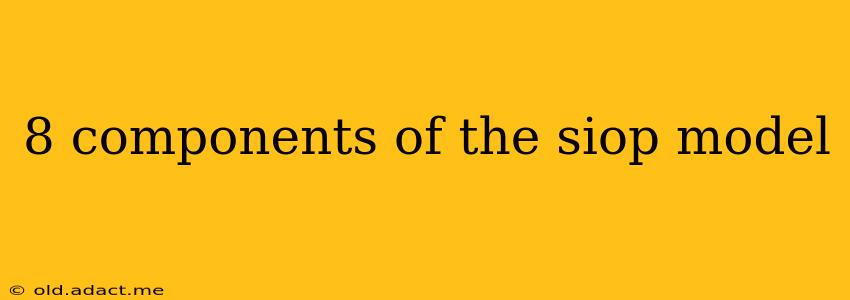The 8 Components of the SIOP Model: A Comprehensive Guide for Effective Instruction
The Sheltered Instruction Observation Protocol (SIOP) model is a research-based framework designed to enhance the academic achievement of English learners (ELs). It provides a structured approach to teaching content while simultaneously developing students' English language proficiency. This comprehensive guide delves into each of the eight components, explaining their importance and offering practical examples.
What is SIOP? SIOP isn't just a set of rules; it's a philosophy that emphasizes creating a supportive and engaging classroom environment where ELs can access grade-level content. It acknowledges the challenges ELs face and provides a pathway for successful learning.
The 8 Components of the SIOP Model:
The SIOP model is organized into eight interconnected components, each crucial for effective sheltered instruction. These components are further divided into 30 features. Let's explore them:
1. Lesson Preparation: This foundational component emphasizes planning that directly addresses the needs of ELs.
- Content Objectives: Clearly defined learning goals that specify what students will know and be able to do. For example, "Students will be able to identify the main idea and supporting details in a nonfiction text."
- Language Objectives: Explicitly stated goals that focus on language development. This might include, "Students will be able to use transition words to connect ideas in their writing."
- Materials: Selecting appropriate materials considering the ELs' language proficiency level. This could involve using visuals, graphic organizers, simplified texts, or bilingual dictionaries.
- Adaptation of Content: Modifying the curriculum to make it accessible to ELs, without compromising the core content. This might involve pre-teaching key vocabulary or breaking down complex tasks into smaller, manageable steps.
2. Building Background: Activating prior knowledge is key to successful learning, especially for ELs.
- Connecting to Prior Knowledge: Using various techniques like brainstorming, KWL charts, or discussions to activate students' existing knowledge related to the lesson topic.
- Direct Instruction: Explicitly teaching necessary background information that students may lack. This could involve providing context, explaining cultural references, or presenting relevant vocabulary.
3. Comprehensible Input: Ensuring that students understand the lesson content is vital.
- Appropriate Speech: Using clear and concise language, adjusting the pace and complexity of speech to match the students' language level.
- Clear Explanation: Providing thorough and understandable explanations of concepts and procedures.
- Strategies: Incorporating various instructional strategies like modeling, think-alouds, or cooperative learning activities to enhance comprehension.
- Use of Visuals: Utilizing visual aids such as pictures, diagrams, realia, and multimedia resources to support understanding.
4. Strategies: Employing effective teaching strategies promotes active engagement and deeper learning.
- Interactive Activities: Engaging students in activities that require them to interact with the content and each other. This includes pair work, group discussions, and hands-on activities.
- Grouping: Using various grouping strategies such as whole-class instruction, small-group work, or individual tasks to cater to different learning styles and needs.
- Questioning Strategies: Employing various questioning techniques (open-ended, clarifying, etc.) to assess understanding and promote critical thinking.
- Opportunities for Student Practice: Providing ample opportunities for students to practice using the language and concepts learned. This might involve writing activities, speaking tasks, or problem-solving exercises.
5. Interaction: Maximizing opportunities for interaction enhances language development and content learning.
- Opportunities for Interaction: Providing numerous opportunities for students to interact with the teacher and their peers. This could involve discussions, debates, presentations, or role-playing activities.
- Grouping: Using effective grouping strategies to facilitate interaction and collaboration.
- Wait Time: Providing sufficient wait time for students to process information and formulate responses.
6. Practice and Application: Reinforcing learning through repeated practice is crucial for long-term retention.
- Activities: Incorporating a variety of activities that allow students to practice using the new language and content in meaningful ways.
- Hands-on Activities: Offering opportunities for students to engage in hands-on activities that reinforce learning.
7. Lesson Delivery: Effective delivery ensures students are actively engaged and understand the instruction.
- Content Objectives: Clearly stating the learning objectives.
- Language Objectives: Explicitly stating the language learning goals.
- Review of Previous Learning: Reviewing previous learning to connect to new information.
- Pacing: Adjusting the pace of instruction to meet the needs of students.
- Student Support: Providing clear instructions and scaffolding.
8. Review and Assessment: Regular review and assessment are vital for monitoring student progress and adjusting instruction.
- Review of Key Vocabulary: Reviewing key vocabulary and concepts throughout the lesson.
- Review of Content: Reviewing the lesson content.
- Feedback: Providing regular feedback to students on their progress.
- Assessment: Using various assessment methods such as oral questioning, writing assignments, or projects to gauge student understanding.
By diligently implementing these eight components, educators can create a truly effective learning environment for English learners, fostering both academic success and language acquisition. Remember, the key is to integrate these components seamlessly into your teaching, rather than treating them as a checklist.
